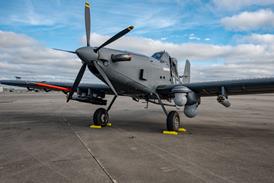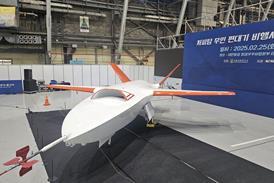Paul Duffy/BOCA RATON, FLORIDA
THE DEMAND FOR OLDER aircraft, particularly for freighters, is rising strongly because operators are beginning to realise that the economics of using older aircraft can result in considerable cost savings.
According to Boeing and McDonnell Douglas (MDC), world air cargo will continue to grow at a rate of 6.3% a year for the next ten years and the need for medium-category freighters (with payloads of 36,300-77,200kg) will grow from fewer than 200 in 1990 to 600 in 2005. Bill Gray, vice-president and general manager of freight carrier American International Airways, predicts that only a small proportion of these aircraft will be new, with conversions of passenger aircraft filling most of the need.
Airclaims says that the numbers of parked and stored jet airliners have fallen consistently, from 874 in March 1995 to 668 in January 1996, with a small increase in February 1996 (to 675), while Edmund Greenslet, vice-chairman of Airline Capital Associates, says that surplus-aircraft numbers peaked at 1,136 in 1993, but dropped to just under 600 by the end of 1995. The market, he says, needs a minimum of 200 surplus aircraft to maintain activity. He forecasts that the numbers will fall below that in 1998.
Speaking at the International Society of Transport Aircraft Trading's conference at Boca Raton, Florida, in March, Northwest vice-president Dan Matthews said that there has been a slowdown in retirements of the MDC DC-9 and similar-generation aircraft because "-major airlines, including Delta, United, Northwest and even American, look at the cost of replacements". Northwest operates 175 DC-9s/MD-80s of all sizes, from the -10 to the MD-82, ranging in vintage from 1966 to 1983. In the past two years, Northwest has bought 41 DC-9s, including many ex-Alitalia aircraft.
Originally built for 40,000 cycles, or 30,000 flight hours, the DC-9 is now approved for more than 100,000 cycles, or 75,000h. Matthews says that MDC has tested a DC-9 up to 208,000 cycles, "without a failure".
Northwest has replaced some of its Boeing 727s (three crew, three engines) with DC-9s (two crew, two engines) for its 100-seat market. On average, the airline's DC-9 fleet has 68,400 cycles, and Matthews regards the type as being well produced and problem-free. "We have looked closely at the operating, plus capital, costs of a new aircraft, compared to our DC-9s, and we calculate that, with current costs of aircraft, plus operations, we will plan to keep some 140 aircraft for a further ten years and reckon that this will save us some $1.4 billion," he says.
Modernisation costs
There is a cost attached to this, however, according to Matthews. "We will spend $3 million per aircraft, to include hushkitting [$1.8 million each], and for a more modern interior [$1.2 million]. The aircraft which have had this work done to date have generated a favourable response from passengers," he says.
Other aircraft types do not meet such approval. John Flynn, executive vice- president of marketing at General Electric Capital Aviation Services, is not enthusiastic about older Boeing 747s, for example. He says that, with the exception of freighters, no widebody of 25 years old has a residual value above scrap, mainly because of the improved operating economics of new- technology aircraft.
He says that there are 170 747-100s and 354 -200s in service today, with another 38 -200s available, or in store. He says that, were there a buyer, any of those aircraft in service would be available for purchase.
"The current lease rate for a 747 is $200,000-$400,000 per month," he says. "If you can fill it, there is no better aircraft, but a high-gross-weight 747-200 of 1980 vintage, with a number six wing, has a maximum value of $15-20 million. Freighter conversion costs $20 million if done by Boeing, or $12 million by others. Attainable lease rates cannot support a value in excess of $20 million for any -200, or $25 million for a -300, and analysis suggests that these values are in permanent and terminal decline."
Although Glen Beecher, senior vice-president of freight forwarder Burlington Air Express, is enthusiastic about MDC DC-8-50s, he says that Stage 3 noise regulations will be difficult to meet and that spares support is "dwindling". Of the 133 -50s built between 1960 and 1965, "fewer than half" are still in service.
On the other hand, values of the DC-8 Series 60 and 70 have held well and, with demand for passenger and freighter aircraft, Beecher anticipates reasonable residual values for the -60s until 1998 and for the -70s until 2003. He also expects the -60 to remain in service for up to 50 years. Potential replacements - the Boeing 757 freighter, or freighter-converted Airbus A300, Lockheed L-1011 TriStar, MDC DC-10, or Boeing 767 - are either costly or scarce, "-and widebodies don't necessarily adapt to narrowbody loads and equipment", Beecher says.
American International's Gray says that his company decided to replace some DC-8s with freighter-converted Lockheed TriStars. In 1994, the airline took delivery of four ex-British Airways TriStar 200s. At first, the lending-rating agencies were wary of funding old aircraft (they were built in 1979/80), but, after the airline had outlined its reasons, they took a positive view.
The TriStar is a Stage 3 aircraft, and the -200 has 45kN (10,000lb) more engine thrust than that of the earlier -1. Gray does not consider converting the older aircraft to freighters as worthwhile, but says that the -200s could all be converted and the smaller, but longer-range, -500s "-might be worth the conversion".
Source: Flight International























